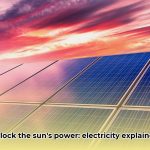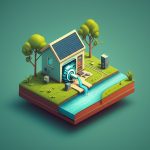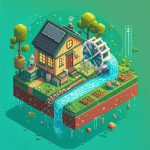What is Tidal Energy?
Ever seen the ocean’s tides coming in and going out? That amazing movement of water holds a surprising amount of energy – enough to power our homes and even entire cities! This incredible power source is called tidal energy, and it’s a type of renewable energy, meaning it won’t run out like fossil fuels (coal and oil). It’s like a giant, natural battery that recharges with every tide! Ready to learn how it works? Let’s dive in!
How Do We Get Electricity from Tides?
We can harness the power of the tides in two main ways: tidal barrages and tidal stream generators.
Tidal Barrages: Like Giant Dams in the Ocean
Imagine a really big dam built across a bay or estuary. That’s similar to a tidal barrage! Here’s how it works:
- The Tide Rises: As the tide comes in, gates in the barrage open, allowing the water to fill the basin behind the dam.
- Trapping the Water: When the tide reaches its highest point, the gates close, trapping a huge amount of water behind the barrage.
- Releasing the Flow: As the tide goes back out, the water level outside the barrage drops. When there’s a big difference in water level between the basin and the ocean, the gates are opened.
- Spinning the Turbines: The trapped water rushes out through tunnels in the barrage, spinning turbines like giant underwater windmills.
- Generating Electricity: These spinning turbines power generators, creating clean electricity!
Tidal Stream Generators: Underwater Windmills
These are like wind turbines, but underwater! They’re placed in areas with strong tidal currents, those fast-moving streams of water created by the tides. As the water flows past, it spins the turbine blades, generating electricity. Pretty cool, right?
Why is Tidal Energy Important?
Tidal energy is a big deal for several reasons:
- It’s clean: Unlike burning fossil fuels, tidal energy doesn’t release harmful greenhouse gases that pollute the air and contribute to climate change.
- It’s reliable: Tides are predictable. We know exactly when high and low tides will occur, making tidal energy a reliable power source, unlike solar or wind energy that depends on the weather.
- It’s renewable: We’ll always have tides, so we won’t run out of this energy source!
Tidal Energy Around the World
Tidal energy projects are popping up all over the globe! Here are a few examples:
- Sihwa Lake Tidal Power Station (South Korea): This is one of the largest tidal power plants in the world, using a barrage system.
- Rance Tidal Power Station (France): This is another example of a tidal barrage, showing that this technology has been around for a while.
- Annapolis Royal Generating Station (Canada): This smaller barrage shows how tidal energy can work even in locations with smaller tides.
- MeyGen (Scotland, UK): This exciting project uses underwater turbines to harness the power of tidal streams.
Pros and Cons of Tidal Energy
Like anything, tidal energy has its upsides and downsides:
| Pros | Cons |
|---|---|
| Clean and renewable | High initial costs to build |
| Predictable and reliable | Can potentially affect marine life (though studies are ongoing) |
| Doesn’t produce greenhouse gases | Only suitable in locations with large tidal ranges |
| Long lifespan (tidal barrages especially) | May impact navigation and shipping |
A Look Back: Tidal Mills
Did you know people have been using tidal power for hundreds of years, even before electricity? Way back in the past, people built tidal mills. These mills used the incoming and outgoing tides to turn water wheels, grinding grain into flour. Pretty ingenious!
The Future of Tidal Energy
Scientists and engineers are working hard to make tidal energy even better. They’re developing more efficient turbines, exploring new types of barrages that are kinder to marine life (like tidal lagoons), and finding ways to harness tidal energy in more places. It’s an exciting field with lots of potential for the future!
What You Can Do
Want to learn more? Check out these awesome resources:
- Fun Kids Live’s website (Search for “tidal energy” or “renewable energy”)
- Enn & Gee’s Meter Motivator (Find out how to save energy at home!)
- National Geographic Kids (Look up articles about oceans and energy)
You can also make a difference right now by saving energy at home. Turn off lights when you leave a room, unplug electronics you’re not using, and take shorter showers. Every little bit helps!
- Water Mill Electricity Generator Provides Free Home Power - December 16, 2025
- Water Wheel Electric Generator Provides Free Home Electricity - December 15, 2025
- Choosing the Right Portable Hydro Turbine for Your Needs - December 14, 2025
















